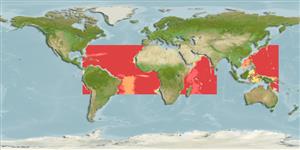>
Ophidiiformes (Cusk eels) >
Ophidiidae (Cusk-eels) > Neobythitinae
Etymology: Acanthonus: Greek, akantha = thorn + Greek, onos = hake.
More on author: Günther.
Environment: milieu / climate zone / depth range / distribution range
Ecología
marino batipelágico; rango de profundidad 1171 - 4415 m (Ref. 75877). Deep-water; 36°N - 23°S, 81°W - 154°E
In deep waters off tropical and subtropical areas of all oceans. Especially abundant in the tropical western Atlantic (Ref. 3686). Reported from Carlsberg Ridge (6°22'N 60°12'E) and New Guinea (Ref. 33390). Known from Gulf of Mexico, Caribbean Sea, southern India, Philippines, Gulf of Panama and tropical west Africa (Ref. 44076).
Tamaño / Peso / Age
Maturity: Lm ? range ? - ? cm
Max length : 37.5 cm SL macho / no sexado; (Ref. 34024)
Short description
Claves de identificación | Morfología | Morfometría
Head large and body tapering. Snout with prominent, bifid spine. Opercular spine long and slender extending well beyond rear margin of head. Well developed spines at lower angle of preopercle. Eye small. Anterior gill arch with 16-22 developed rakers. Precaudal vertebrae 9-10.
Benthopelagic at bathyal and abyssal depths (Ref. 56809). Common species (Ref. 34024). Oviparous, with oval pelagic eggs floating in a gelatinous mass (Ref. 205). Noted as having the smallest relative brain size among teleosts, and remarkably large semicircular canals (Ref. 7463).
Life cycle and mating behavior
Madurez | Reproducción | Puesta | Huevos | Fecundidad | Larva
Nielsen, J.G., 1990. Ophidiidae. p. 564-573. In J.C. Quero, J.C. Hureau, C. Karrer, A. Post and L. Saldanha (eds.) Check-list of the fishes of the eastern tropical Atlantic (CLOFETA). JNICT, Lisbon; SEI, Paris; and UNESCO, Paris. Vol. 2. (Ref. 3686)
IUCN Red List Status (Ref. 130435: Version 2024-1)
Threat to humans
Harmless
Human uses
Pesquerías: sin interés
Herramientas
Special reports
Download XML
Fuentes de Internet
Estimates based on models
Preferred temperature (Ref.
123201): 1.8 - 4.1, mean 2.7 °C (based on 1440 cells).
Phylogenetic diversity index (Ref.
82804): PD
50 = 1.0000 [Uniqueness, from 0.5 = low to 2.0 = high].
Bayesian length-weight: a=0.00110 (0.00040 - 0.00297), b=3.08 (2.85 - 3.31), in cm total length, based on LWR estimates for this (Sub)family-body shape (Ref.
93245).
Nivel trófico (Ref.
69278): 3.6 ±0.6 se; based on size and trophs of closest relatives
Resiliencia (Ref.
120179): Medio, población duplicada en un tiempo mínimo de 1.4-4.4 años (Preliminary K or Fecundity.).
Fishing Vulnerability (Ref.
59153): Moderate vulnerability (36 of 100).
